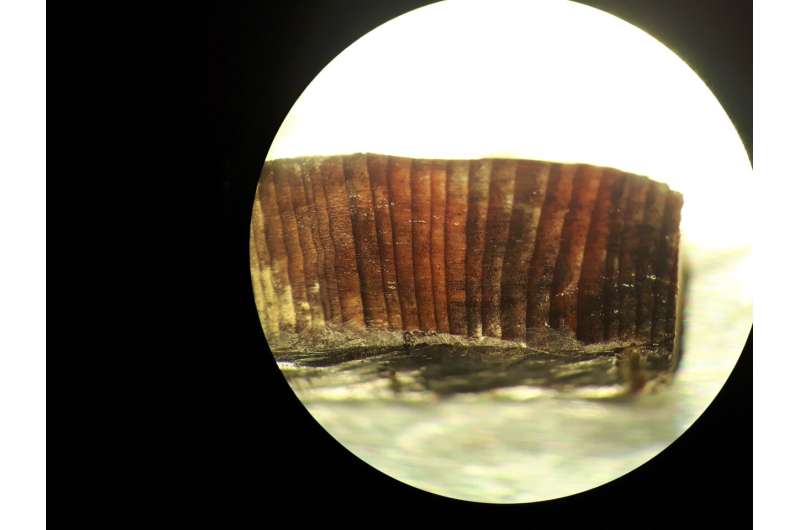Columbus was not the first European to reach the Americas. The Vikings got there centuries before, although exactly when has remained unclear. Here, an international team of scientists show that Europeans were already active in the Americas in 1021 AD.
The Vikings sailed great distances in their iconic longships. To the west, they established settlements in Iceland, Greenland and eventually a base at L'Anse aux Meadows, Newfoundland, Canada. However, it has remained unclear when this first transatlantic activity took place. Here, scientists show that Europeans were present in the Americas in 1021 AD—precisely 1,000 years ago this year. This date also marks the earliest known point by which the Atlantic had been crossed, and migration by humankind had finally encircled the entire planet.
A solar storm solution
In this study, the chopping of wood by Vikings at L'Anse aux Meadows was dated to exactly the year 1021 AD. The three pieces of wood studied, from three different trees, all came from contexts archaeologically attributable to the Vikings. Each one also displayed clear evidence of cutting and slicing by blades made of metal—a material not produced by the indigenous population. The exact year was determinable because a massive solar storm occurred in 992 AD that produced a distinct radiocarbon signal in tree rings from the following year.
"The distinct uplift in radiocarbon production that occurred between 992 and 993 AD has been detected in tree-ring archives from all over the world," says Associate Professor Michael Dee (University of Groningen), director of the research. Each of the three wooden objects exhibited this signal 29 growth rings (years) before the bark edge. "Finding the signal from the solar storm 29 growth rings in from the bark allowed us to conclude that the cutting activity took place in the year 1021 AD" says Dr. Margot Kuitems (University of Groningen), first author of the paper.
Microscope image of a wood fragment from the Norse layers at L’Anse aux Meadows. Credit: Petra Doeve, University of Groningen
How far, how often?
The number of Viking expeditions to the Americas, and the duration of their stay over the Atlantic, remain unknown. All current data suggest that the whole endeavor was somewhat short lived, and the cultural and ecological legacy of this first European activity in the Americas is likely to have been small. Nonetheless, botanical evidence from L'Anse aux Meadows has confirmed that the Vikings did explore lands further south than Newfoundland.
< View the video at the source page. >
This video introduces ECHOES - Exact Chronology of Early Societies, a 5-year project funded by the European Research Council and based at the University of Groningen. Its central aim is to develop a new approach to radiocarbon dating, one that is accurate to the exact calendar year. The technique will be built on the recent discovery of annual rises, or ‘spikes’, in the concentration of radiocarbon in the atmosphere. Credit: ESRIG - Energy and Sustainability Research Institute Groningen, Pix Videos
The sagas
1021 AD is the earliest year in which European presence in the Americas can be scientifically proven. Previous dates for the Viking presence in the Americas have relied heavily on the Icelandic Sagas. However, these began as oral histories and were only written down centuries after the events they describe. Whilst contradictory and at times fantastical, the Sagas also suggest encounters occurred, both violent and amiable, between the Europeans and the indigenous people of the region. However, little archaeological evidence has been uncovered to support such exchanges. Other medieval accounts also exist, which imply prominent figures on the European mainland were made aware the Vikings had made landfall across the Atlantic.
The study is published in Nature.
- Karlston
-

 1
1




Recommended Comments
There are no comments to display.
Join the conversation
You can post now and register later. If you have an account, sign in now to post with your account.
Note: Your post will require moderator approval before it will be visible.